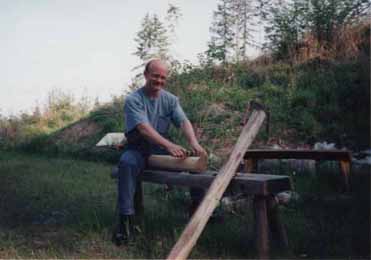 Allow me to introduce myself. My name is Robert Matteson. I have lived on Whidbey Island, Washington, for 7 years, am a native Washingtonian, and am proud to call Whidbey Island my home and source of inspiration.
Allow me to introduce myself. My name is Robert Matteson. I have lived on Whidbey Island, Washington, for 7 years, am a native Washingtonian, and am proud to call Whidbey Island my home and source of inspiration.
I come from a family of island artists and craftspersons; some of their ways were bound to wear off onto me. I have been interested in woodworking and log smithing since childhood. This interest has recently taken shape into more than a hobby to become my livelihood.
I have always enjoyed the transformation of wood and logs into something useful, beautiful, even artistic, although I don't care for that word. Instead, I prefer to think of myself as a Logsmith, a form of wood sculptor, if you will. A far cry from art, I do feel my pieces reflect a certain artistic quality. The ability to design, and then build a piece, is my driving force to create and build another, and another, and another. My ideas are simple and frontier-like. Each piece retains one or more small elements to remind people of the wood's origin, maybe a small branch or an interesting knot, a "catface" or a burl. These irregularities, in my opinion, enhance the natural beauty and simplicity, while giving each piece its own character.
My materials vary in species, but all are individually selected for size, shape, and character. The wood itself comes from selective thinning operations in our area, as well as other parts of Washington State. The term "selective thinning" can best be described as a process in which small, underdeveloped, or clustered trees are selectively removed, thus making the remaining trees healthier. This is done using a very minimal-impact method. The material from this process is small, crooked, and is generally undesirable to the timber industry. It is usually left in slash piles or is burnt on site, both of which I'm sure you've seen wherever you live. My work allows me to convert this "waste" into beautiful, functional art, AKA furniture.
After bringing the logs and branches to my studio workshop, I carefully remove the bark using drawknives and muscle. I smooth the logs with spoke shaves and sandpaper, then create the mortise and tenon joinery using specialized equipment and techniques developed especially for log work.
Most of my work is custom order, and I heartily encourage creative input from my customers. My works include, but are not limited to, beds, bar and counter stools, tables, chairs, log-framed mirrors, log railing, log accents used in architecture, log fireplace mantles, outdoor swings and furniture, and many other items.